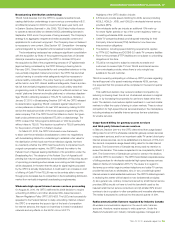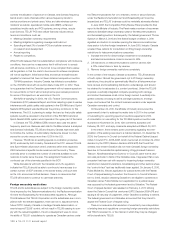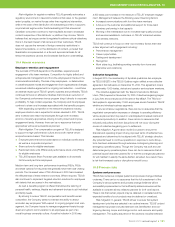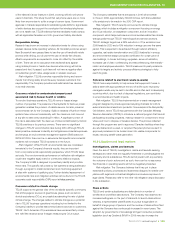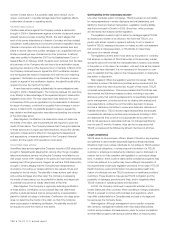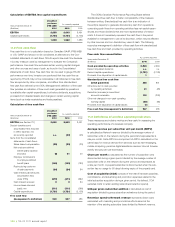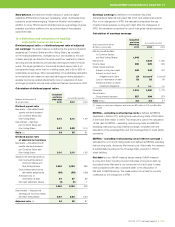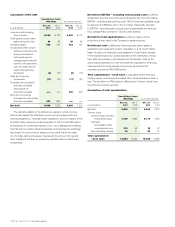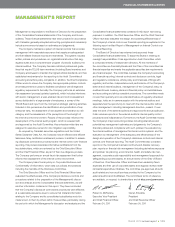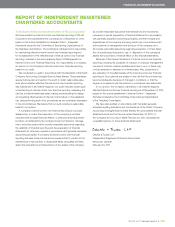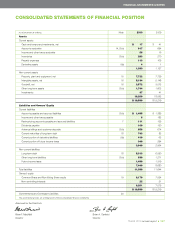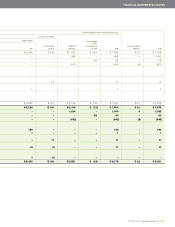Telus 2010 Annual Report Download - page 113
Download and view the complete annual report
Please find page 113 of the 2010 Telus annual report below. You can navigate through the pages in the report by either clicking on the pages listed below, or by using the keyword search tool below to find specific information within the annual report.
TELUS 2010 annual report . 109
The discussion in this section is qualified in its entirety by the Caution
regarding forward-looking statements at the beginning of the MD&A.
IFRS-based financial information provided in this section is subject
to change, as described further in Section 8.2 Accounting policy
developments.
11.1 Earnings before interest, taxes, depreciation
and amortization (EBITDA)
EBITDA is not a calculation based on Canadian GAAP, IFRS-IASB
or U.S. GAAP. EBITDA should not be considered an alternative to Net
income in measuring the Company’s performance, nor should it be
used as an exclusive measure of cash flow. TELUS has issued guidance
on and reports EBITDA because it is a key measure that management
uses to evaluate performance of segments and the Company. EBITDA –
excluding restructuring costs is also utilized in measuring compliance
with debt covenants (see description in Section 11.4). EBITDA is a mea-
sure commonly reported and widely used by investors as an indicator
of a company’s operating performance and ability to incur and service
debt, and as a valuation metric. While EBITDA has been disclosed
herein to permit a more complete comparative analysis of the Company’s
operating performance and debt servicing ability relative to other
companies, investors are cautioned that EBITDA as reported by TELUS
may not be comparable in all instances to EBITDA as reported by
other companies.
After changeover to IFRS, management intends to present standard-
ized EBITDA (CICA guideline) in its disclosures, and may periodically
also calculate an adjusted EBITDA that will exclude items of an unusual
nature that do not reflect normal or ongoing telecommunications oper-
ations, that should not be considered in a valuation metric or should not
be included in assessment of ability to service or incur debt.
The CICA’s Canadian Performance Reporting Board defined
standardized EBITDA to foster comparability of the measure between
entities. Standardized EBITDA is an indication of an entity’s capacity
to generate income from operations before taking into account manage-
ment’s financing decisions and costs of consuming tangible and
intangible capital assets, which vary according to their vintage, tech-
nological currency and management’s estimate of their useful life.
Accordingly, standardized EBITDA comprises revenue less operating
costs before interest expense, capital asset amortization and
impairment charges, and income taxes. Management’s definition
of EBITDA differs from standardized EBITDA, as illustrated below:
Calculation of EBITDA
Unaudited
pro forma
Years ended December 31 IFRS-IASB As currently reported
($ millions) 2010 2010 2009
Net income 1,052 1,038 1,002
Financing costs 522 510 532
Income taxes 335 328 203
Depreciation 1,339 1,333 1,341
Amortization of intangible assets 402 402 381
Impairment losses (reversals)
for capital assets – – –
Standardized EBITDA
(CICA guideline) 3,650 3,611 3,459
Other expense, net 32 32
EBITDA (management’s definition) 3,643 3,491
As EBITDA is often used as a valuation metric, an analysis of the pro
forma difference in EBITDA arising from the transition to IFRS is presented
in the following table. The effects of transition on individual line items on
the Consolidated statement of income and other comprehensive income
are presented in more detail in Section 8.2.3.
Analysis of the difference in management’s
definition of EBITDA following the transition to IFRS
Year ended December 31 ($ millions) 2010
EBITDA (as currently reported) 3,643
IFRS recognition, measurement, presentation
and disclosure effects
Other operating income (in revenues
rather than Other expense, net) 2
Charitable donations expense
(in Operating expenses rather
than Other expense, net) (26)
Employee benefits – defined benefit plans 39
Leasing – sales and leaseback transactions (12)
Asset retirement obligations 4
EBITDA (unaudited pro forma IFRS-IASB) 3,650
Management also calculates EBITDA less capital expenditures
as a simple proxy for cash flow at a consolidated level and in its two
reportable segments. EBITDA less capital expenditures may be used
for comparison to the reported results for other telecommunications
companies over time and is subject to the potential comparability issues
of EBITDA described above.
MANAGEMENT’S DISCUSSION & ANALYSIS: 11
11 DEFINITIONS AND RECONCILIATIONS
Definitions of operating, liquidity and capital resource measures, including calculation
and reconciliation of certain non-GAAP measures used by management


